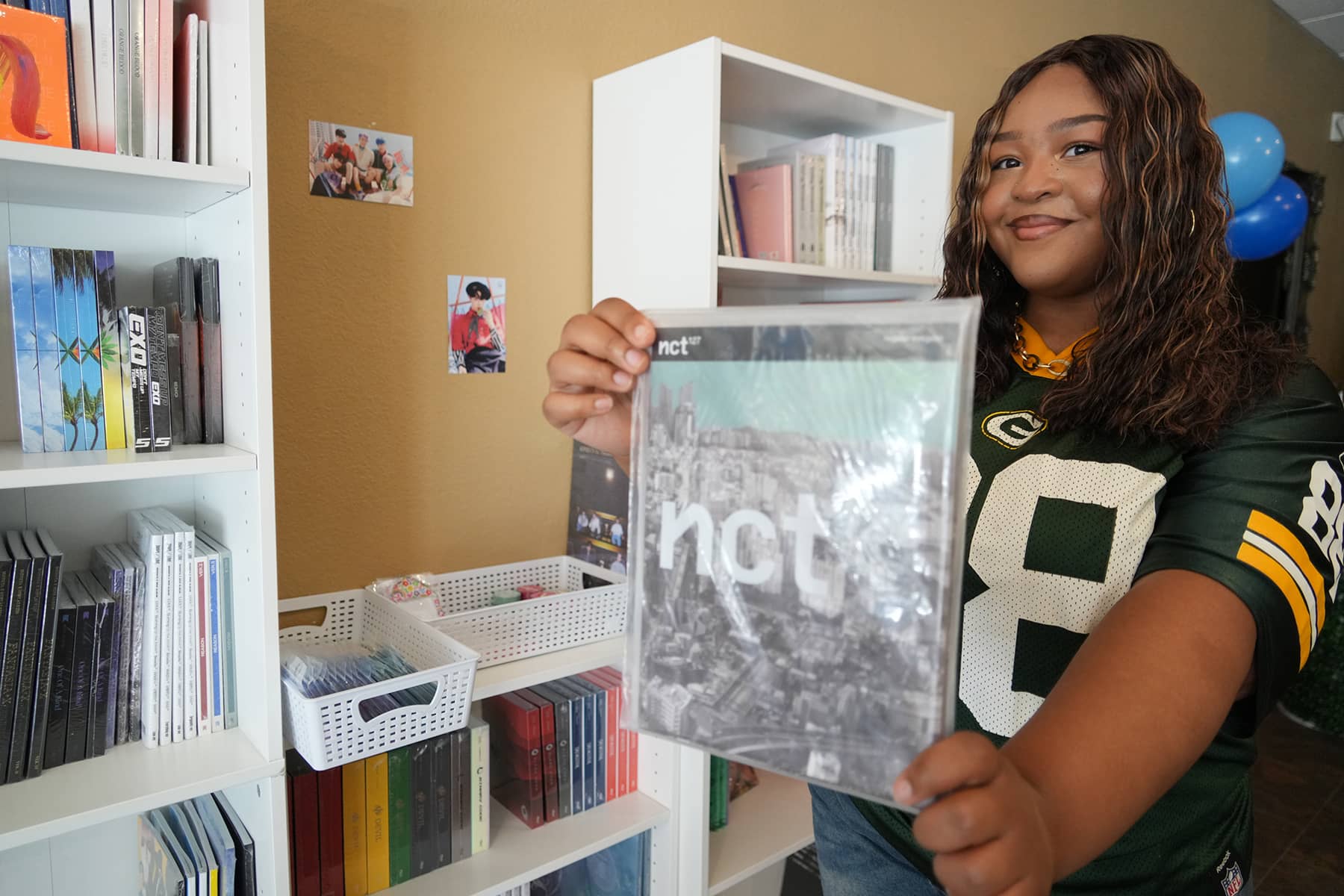
The export of South Korean culture over the past two decades, known as Hallyu or the Korean Wave, transformed what was a regional curiosity into a global powerhouse, captivating millions worldwide. Residents of Milwaukee have embraced the phenomenon, with a particular interest in K-pop, and area businesses stand to both learn from and profit by the influential music trend.
Milwaukee has seen a surge of interest in Korean culture, driven by the global popularity of K-pop, K-dramas, and Korean cuisine. Local K-pop fan clubs have formed to host events and meet-ups that bring fans together, fostering a sense of community and cultural exchange. The gatherings often include dance covers, karaoke sessions, and discussions about favorite groups and idols in the South Korean entertainment industry.
Short for “Korean popular music,” K-pop is a genre that originated in South Korea in the early 1990s. Its contemporary form, characterized by a blend of various musical styles, captivating visuals, and intricate choreography, has evolved significantly over the years. K-pop groups like BTS and BLACKPINK have achieved international fame, topping global music charts, and performing at major venues around the world.
Fans of K-pop in Milwaukee have found it challenging at times to share their interest with others. People often need either exposure or education about something in pop culture before they adopt it. Many may also have preconceived notions about K-pop, viewing it as foreign or niche, making it harder for enthusiasts to generate interest and understanding.
“I discovered K-pop online, and that’s mostly how I experienced it before I met others who shared my interest,” said Yanna, a student in Milwaukee. “I would watch BTS at the time on YouTube, and some people were surprised I liked ‘that music.’ They’d ask when I started listening to Chinese music. So I’d explain it’s not Chinese, it’s K-pop. It’s Korean – it’s in the name.”
K-pop’s history began with idol groups like H.O.T. (Highfive of Teenagers) and S.E.S. (an acronym for Sea, Eugene, Shoo), who are often credited with pioneering the genre. They introduced a fusion of Korean music with Western pop elements, incorporating rap, rock, and techno. It was a novel concept in South Korea at the time, but it would become the hallmark of K-pop today.
Hallyu, or Korean Wave, and the 1980s Japanese anime wave both represent significant cultural exports from East Asia that have had profound impacts on global popular culture. While there are similarities in how they spread and were embraced by international audiences, there are also distinct differences in their origins, mediums, and impacts.
While American entertainment companies played a large role in helping to export content from businesses already thriving in Japan, the South Korean government was instrumental in engineering the Korean entertainment industry. It was relatively underdeveloped, with limited global reach and influence, before the intervention.
In the late 1980s, South Korea’s music and entertainment industry was dominated by traditional music and trot, a genre of Korean pop music characterized by its repetitive rhythms and vocal inflections. Western pop culture had a limited influence, and there were fewer platforms and opportunities for local artists to gain widespread recognition, both domestically and internationally. The industry lacked the infrastructure, investment, and strategic vision needed to compete on a global scale.
When the Hollywood film “Jurassic Park” was released in 1993, it earned over $914 million worldwide. It was a figure that surpassed the combined annual net profits of South Korea’s major industrial giants like Hyundai Motor and Samsung Electronics. The stark contrast underscored the enormous economic potential of the cultural and entertainment industries.
Following the Asian financial crisis in the late 1990s, the South Korean government recognized the value of cultural exports as a means to both diversify and boost the economy. That realization led to the introduction of policies aimed at developing the entertainment sector. The government started investing heavily in cultural infrastructure, including the establishment of the Korean Film Council and various music and arts institutions.
Milwaukee has embraced K-pop through various activities and community efforts, reflecting its growing popularity. K-pop events and concerts have been hosted by local fan clubs and cultural organizations, drawing significant crowds and often selling out of merchandise quickly.
K-pop dance classes and cover groups have emerged, allowing fans to learn and perform intricate choreography. Active K-pop fan clubs, often based at Milwaukee high schools or Universities, and online groups have helped foster a sense of community and support among the fan base.
For K-pop enthusiast, Alyssa Ehlers, her first experience with K-pop went back to 2008, when she started watching YouTube videos. Over the years since, she has fully embraced K-pop by buying albums and attending concerts. Yet, she found it challenging to access K-pop merchandise and events locally.
“I live in Kaukauna, which is near Appleton. But I was visiting Milwaukee, and it has a K-pop store. So I was excited to go there and shop. It’s a lot closer than having to drive to Chicago,” said Ehlers. “I have already made new friends in Milwaukee who are also into K-pop. That’s kind of nice because when I started, there wasn’t really anyone that I knew who liked K-pop.”
Alyssa’s K-pop collection is extensive, with about 780 albums. Despite the availability of K-pop music on Apple iTunes now, she continues to buy physical products. Music CDs often include photo books, photo cards, posters, and sometimes unique and highly collectible items.
“Back before K-pop groups came to America, the only way I could support them was to buy their albums,” Ehlers added. “It was hard when they didn’t come here for concerts. But enough people would buy their merch online, which I think showed they could profit from performances here.”
A big component of K-pop’s success can be attributed to the structured and strategic approach taken by the South Korean entertainment industry. Companies such as SM Entertainment, YG Entertainment, and JYP Entertainment implement a rigorous training system where young talents, often recruited as teenagers, undergo years of intensive training in singing, dancing, acting, and foreign languages.
The “idol” system ensures that by the time the trainees debut, they are highly skilled performers. These companies also invest heavily in high-quality music production, eye-catching music videos, and elaborate stage performances, creating a polished and appealing product.
The Korean entertainment industry, despite its global success and glamorous image, also faces numerous challenges and controversies. Key issues include intense pressure on performers, leading to severe mental health struggles. The most tragic cases, as seen in the suicides of Jonghyun from SHINee and Sulli from f(x), are an example of the seriousness of the problem.
In addition, exploitative contracts signed at a young age are used to bind idols to long-term, unfair agreements with little control over their lives. Rigorous training regimens, demanding over 10 hours of practice daily, can result in physical injuries and chronic health problems, compounded by strict diets leading to eating disorders.
Idols also experience a significant loss of privacy and personal freedom, with management companies tightly controlling their social interactions and public appearances. Sexual harassment and abuse are also serious issues, with powerful industry figures exploiting young performers, highlighted by the #MeToo movement in South Korea.
Cyberbullying and online harassment are rampant, with the anonymity of the internet allowing malicious comments and rumors, contributing to the mental health crises with performers and even suicides, such as with Sulli and Goo Hara.
The industry is also marred by corruption and scandals involving bribery, drug use, and prostitution, as exemplified by the Burning Sun scandal involving Seungri of BIGBANG. These problems not only tarnish individual reputations but also reflect broader systemic issues within the entertainment sector.
Added to that mix is a bigger social problem of “Sasaeng,” extreme K-pop superfans who engage in invasive and illegal activities, such as stalking idols to their homes, hotels, and private schedules, using hidden cameras and GPS trackers, breaking into their homes, and stealing personal information.
Also referred to as “stans,” they constantly harass idols through phone calls, text messages, and physical contact during public appearances. The behavior has even led to legislation for protecting idols from unsafe conditions that affect the mental and physical health of their daily lives. But enforcement can be challenging, since it is often the obsessive behavior of fan loyalty that drives profits for idols and the music industry.
Milwaukee’s highly active youth population grew up on social media platforms where K-pop content thrives, facilitating easy access to music videos, dance challenges, and fan communities. As more Milwaukee residents become exposed to K-pop through various channels, the genre’s appeal is set to expand, fueled by the community’s enthusiasm and the global momentum of K-pop.
With a list of groups like Twice, Red Velvet, Aespa, and (G)I-DLE leading the way, K-pop has solidified its presence on international music charts, concert tours, and social media platforms.
“K-pop is not a fad, in my opinion. I think it’s going to keep growing. Even if it ever becomes stagnant, there’s always going to be fans of it because the Internet offers easy access,” said Tina Melk, owner of K-Pop Utopia, Wisconsin’s first K-pop store located in the Milwaukee County suburb of West Allis. “To me, it is no different than Japanese Anime and that fanbase. It goes in cycles where people fade out but new people come in. It evolves, remains popular, and keeps growing. So I think ten years from now people will still be enjoying K-pop.”
- Exploring Korea: Stories from Milwaukee to the DMZ and across a divided peninsula
- A pawn of history: How the Great Power struggle to control Korea set the stage for its civil war
- Names for Korea: The evolution of English words used for its identity from Gojoseon to Daehan Minguk
- SeonJoo So Oh: Living her dream of creating a "folded paper" bridge between Milwaukee and Korean culture
- A Cultural Bridge: Why Milwaukee needs to invest in a Museum that celebrates Korean art and history
- Korean diplomat joins Milwaukee's Korean American community in celebration of 79th Liberation Day
- John T. Chisholm: Standing guard along the volatile Korean DMZ at the end of the Cold War
- Most Dangerous Game: The golf course where U.S. soldiers play surrounded by North Korean snipers
- Triumph and Tragedy: How the 1988 Seoul Olympics became a battleground for Cold War politics
- Dan Odya: The challenges of serving at the Korean Demilitarized Zone during the Vietnam War
- The Korean Demilitarized Zone: A border between peace and war that also cuts across hearts and history
- The Korean DMZ Conflict: A forgotten "Second Chapter" of America's "Forgotten War"
- Dick Cavalco: A life shaped by service but also silence for 65 years about the Korean War
- Overshadowed by conflict: Why the Korean War still struggles for recognition and remembrance
- Wisconsin's Korean War Memorial stands as a timeless tribute to a generation of "forgotten" veterans
- Glenn Dohrmann: The extraordinary journey from an orphaned farm boy to a highly decorated hero
- The fight for Hill 266: Glenn Dohrmann recalls one of the Korean War's most fierce battles
- Frozen in time: Rare photos from a side of the Korean War that most families in Milwaukee never saw
- Jessica Boling: The emotional journey from an American adoption to reclaiming her Korean identity
- A deportation story: When South Korea was forced to confront its adoption industry's history of abuse
- South Korea faces severe population decline amid growing burdens on marriage and parenthood
- Emma Daisy Gertel: Why finding comfort with the "in-between space" as a Korean adoptee is a superpower
- The Soul of Seoul: A photographic look at the dynamic streets and urban layers of a megacity
- The Creation of Hangul: A linguistic masterpiece designed by King Sejong to increase Korean literacy
- Rick Wood: Veteran Milwaukee photojournalist reflects on his rare trip to reclusive North Korea
- Dynastic Rule: Personality cult of Kim Jong Un expands as North Koreans wear his pins to show total loyalty
- South Korea formalizes nuclear deterrent strategy with U.S. as North Korea aims to boost atomic arsenal
- Tea with Jin: A rare conversation with a North Korean defector living a happier life in Seoul
- Journalism and Statecraft: Why it is complicated for foreign press to interview a North Korean defector
- Inside North Korea’s Isolation: A decade of images show rare views of life around Pyongyang
- Karyn Althoff Roelke: How Honor Flights remind Korean War veterans that they are not forgotten
- Letters from North Korea: How Milwaukee County Historical Society preserves stories from war veterans
- A Cold War Secret: Graves discovered of Russian pilots who flew MiG jets for North Korea during Korean War
- Heechang Kang: How a Korean American pastor balances tradition and integration at church
- Faith and Heritage: A Pew Research Center's perspective on Korean American Christians in Milwaukee
- Landmark legal verdict by South Korea's top court opens the door to some rights for same-sex couples
- Kenny Yoo: How the adversities of dyslexia and the war in Afghanistan fueled his success as a photojournalist
- Walking between two worlds: The complex dynamics of code-switching among Korean Americans
- A look back at Kamala Harris in South Korea as U.S. looks ahead to more provocations by North Korea
- Jason S. Yi: Feeling at peace with the duality of being both an American and a Korean in Milwaukee
- The Zainichi experience: Second season of “Pachinko” examines the hardships of ethnic Koreans in Japan
- Shadows of History: South Korea's lingering struggle for justice over "Comfort Women"
- Christopher Michael Doll: An unexpected life in South Korea and its cross-cultural intersections
- Korea in 1895: How UW-Milwaukee's AGSL protects the historic treasures of Kim Jeong-ho and George C. Foulk
- "Ink. Brush. Paper." Exhibit: Korean Sumukhwa art highlights women’s empowerment in Milwaukee
- Christopher Wing: The cultural bonds between Milwaukee and Changwon built by brewing beer
- Halloween Crowd Crush: A solemn remembrance of the Itaewon tragedy after two years of mourning
- Forgotten Victims: How panic and paranoia led to a massacre of refugees at the No Gun Ri Bridge
- Kyoung Ae Cho: How embracing Korean heritage and uniting cultures started with her own name
- Complexities of Identity: When being from North Korea does not mean being North Korean
- A fragile peace: Tensions simmer at DMZ as North Korean soldiers cross into the South multiple times
- Byung-Il Choi: A lifelong dedication to medicine began with the kindness of U.S. soldiers to a child of war
- Restoring Harmony: South Korea's long search to reclaim its identity from Japanese occupation
- Sado gold mine gains UNESCO status after Tokyo pledges to exhibit WWII trauma of Korean laborers
- The Heartbeat of K-Pop: How Tina Melk's passion for Korean music inspired a utopia for others to share
- K-pop Revolution: The Korean cultural phenomenon that captivated a growing audience in Milwaukee
- Artifacts from BTS and LE SSERAFIM featured at Grammy Museum exhibit put K-pop fashion in the spotlight
- Hyunjoo Han: The unconventional path from a Korean village to Milwaukee’s multicultural landscape
- The Battle of Restraint: How nuclear weapons almost redefined warfare on the Korean peninsula
- Rejection of peace: Why North Korea's increasing hostility to the South was inevitable
- WonWoo Chung: Navigating life, faith, and identity between cultures in Milwaukee and Seoul
- Korean Landmarks: A visual tour of heritage sites from the Silla and Joseon Dynasties
- South Korea’s Digital Nomad Visa offers a global gateway for Milwaukee’s young professionals
- Forgotten Gando: Why the autonomous Korean territory within China remains a footnote in history
- A game of maps: How China prepared to steal Korean history to prevent reunification
- From Taiwan to Korea: When Mao Zedong shifted China’s priority amid Soviet and American pressures
- Hoyoon Min: Putting his future on hold in Milwaukee to serve in his homeland's military
- A long journey home: Robert P. Raess laid to rest in Wisconsin after being MIA in Korean War for 70 years
- Existential threats: A cost of living in Seoul comes with being in range of North Korea's artillery
- Jinseon Kim: A Seoulite's creative adventure recording the city’s legacy and allure through art
- A subway journey: Exploring Euljiro in illustrations and by foot on Line 2 with artist Jinseon Kim
- Seoul Searching: Revisiting the first film to explore the experiences of Korean adoptees and diaspora


































